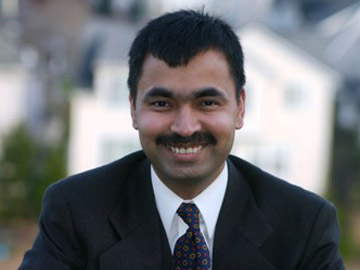
Smartphones: Chetan Sharma Does Crystal-Ball Gazing
Analyst Chetan Sharma talks about smartphone features that will remain, and those that will emerge, in the next two years
Chetan Sharma is founder and president of a US-based management consulting and strategic advisory firm that was started in 2001. He is a recognised expert on mobile communications, wireless data and pervasive computing and has authored and co-authored five books on wireless communications.
It is safe to say that the iPhone-like touchscreen form factor will still be the default one-two years from now, though the screen size may be different. Apple’s iOS and Google’s Android will continue to dominate as operating systems, while Microsoft Windows Phone might, at best, capture 10 percent of the market.
There is also the possibility that there might be some fracturing of the Android ecosystem, for instance, if Samsung were to ‘fork’ Android. But I don’t see iOS and Android losing steam in at least the next 12 months.
This is not to say innovation is dead or slowing down in the space. But we’ll need to qualify what kind of innovations will be called ‘successful’. Will they be those that merely come to the market, or those that achieve a significant market share too?
Clearly, in the next two years we’ll see a lot of new innovations: We’ll see foldable displays that are almost unbreakable; we’ll see some form of biometric authentication on smartphones, like the ones in Japan have had for years.
For instance, a fingerprint sensor may be embedded underneath the screen so that merely swiping across the screen can authenticate you as well. Given that smartphones today are full-blown computers carrying lots of sensitive data and handling many commerce transactions, this will be required.
We may see fuel cells for batteries. Some forms of fuel cells are already being tested for laptops, so it’s only a question of time before we can miniaturise them and make them affordable for smartphones too. Near-field communication (NFC) will be present in almost all smartphones by 2015, in turn enabling all sorts of applications in retail, healthcare and financial services to take off.
We will also see more and more sensors on devices that can do all sorts of things around healthcare, environment and security. An example of what may be possible is Qualcomm’s $10 million X Prize challenge for a ‘tri-corder’ device with sensors that can take physiological readings and diagnose diseases in real time.
Together with apps, we can envision emergency services after a disaster like a fire or earthquake using real-time data from these devices to tailor their responses in real time.
What about completely new form factors, like Google Glass that push the boundaries of what we know of personal computing?
I think they will remain niche in the near term due to two issues: First, they will operate at pretty expensive prices to begin with, and will fall to the $200 to $300 level only in three to five years; second, and more importantly, using them will involve huge behavioural shifts because people are simply not used to wearing and talking to computers.
(As told to Rohin Dharmakumar)
(This story appears in the 22 February, 2013 issue of Forbes India. To visit our Archives, click here.)
Post Your Comment















